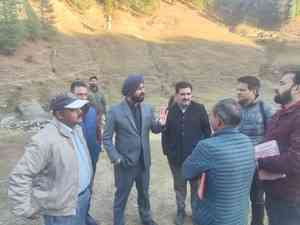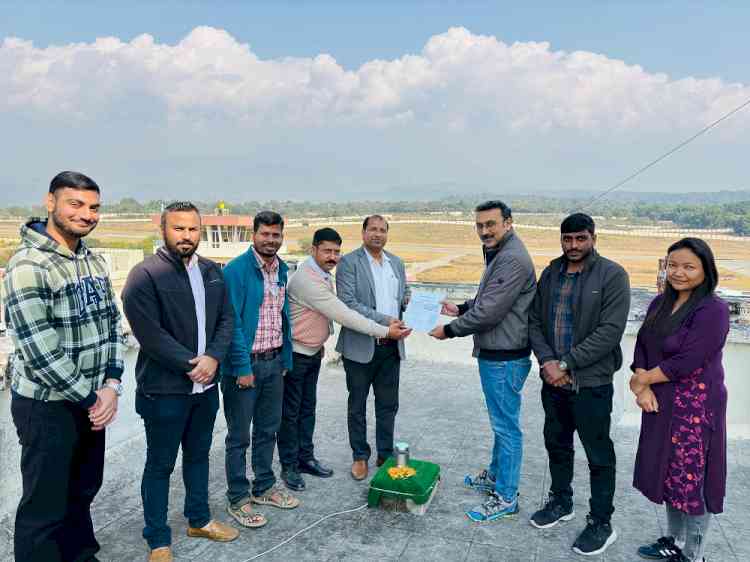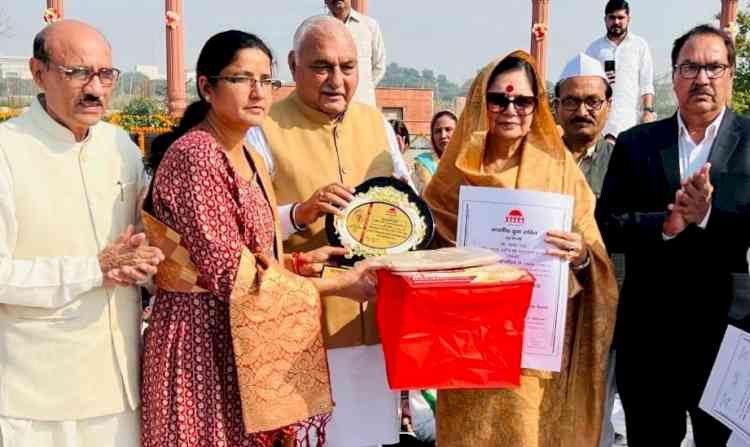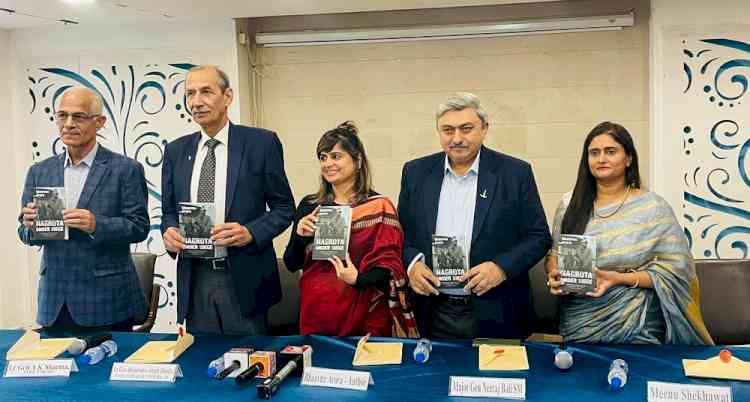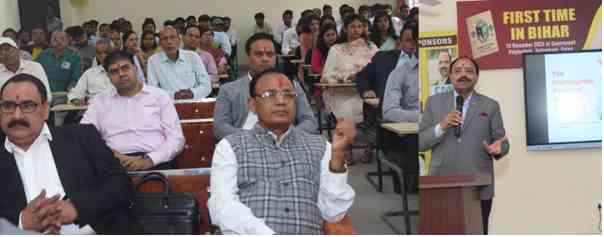India’s biggest conference of Landscape Architects - 14th National Virtual Conference of ISOLA concludes
Bhopal to host next ISOLA Conference in 2024

Hyderabad, February 13, 2022: Ecological Restoration is to bring back to original or a known previous condition said Ketaki Ghate, Founder of OIKOs, India and well known ecologiczl restoration expert. She spoke about of one of her projects in Western Ghats a case study.
The third day which had the theme Renewal began with the highly informative talk by Ketaki Ghate from Oikos. She in her talk elaborately explained the process of restoration or conservation of a landscape, be it through an integrated or purist approach. Through various examples which included a private property restoration in the ecological hotspot of Sahyadri or restoring and connecting patches of vegetation in villages of Maharashtra Ketaki spoke about the stepwise process of conservation and restoration which included the regional understanding, understanding of mature ecosystems, socio-economic survey as well as current ecological condition.
She shared how a 24 acre piece of land owned by some actors which they bough to conserve nature and spend time away from cities. They approached her for ecological services. She and her team suggested conservation through restoration. They have implemented among others an assisted natural regeneration. They have just completed two out of several layers of restoration much to the satisfaction and delight of her customers. This is now considered as the forest of tomorrow. She shared her journey, experience and wisdom for the good of fellow Landscape Architects.
In the second talk of the day Prof GSV Surya Narayan Murthy, the conservation architect behind Ramappa Temple getting UNESCO recognition spoke about the extremely fragile and unique cultural ecosystem of Majauli island. Taking forward from Ketakis presentation he spoke about the wholistic conservation with a minimalistic approach which was considered while intervening in the ecologically sensitive setting of the Majauli island.
The next bi-annual conference of ISOLA will be hosted in the year 2024 Bhopal Chapter of ISOLA
The first ever virtual ISOLA National Conference of ISOLA which was the 14th edition concluded that there was a time that nature and man co-existed harmoniously. And we hope to see the same even in the era of industrialization and modernization.
Indian Society of Landscape Architects (ISOLA) is a 19 years old professional body of Landscape Architects. It has over 360 members from different states of the country and some from across the world. Society is at the forefront in creating global awareness about the fast-emerging profession of Landscape Architecture and promoting and enhancing professional excellence among its members in India. It is a member of the International Federation of Landscape Architects (IFLA).
The mission of ISOLA is to nurture and enhance the profession of landscape architecture by providing leadership in the creation of artful design in our man-made, cultural and natural environments.
750 plus Landscape Architects, including members of ISOLA, along with architects, planners, designers, ecologists participated in it.
The theme of the conference was “Unbuilt landscapes”. The conference was hosted by ISOLA Hyderabad, the home Chapter of Dr Sridevi Rao, Honorary National President of ISOLA.
The inaugural keynote was delivered by Ms. Kotchakorn Voraakhom, Founder and CEO at Landprocess & Porous City Network, Bangkok, a social enterprise that looks to increase urban resilience in Southeast Asia. She has been named one of Thailand's best architects, one who is fostering social change
The keynote by Kotchakorn elaborately explained the impact of landscapes beyond crafting spaces. Not only did her projects make a case for the ecological balance that the landscape architects has been striving to achieve but also spoke about the culture, community, and land connection.
Some of the speakers who spoke include Mr Mohan S. Rao, Principal Design, Integrated Design (INDE) India. He is recognized as one of the leading professionals in passive water management and conservation strategies in South East Asia. He is the recipient of several awards instituted by UNESCO, IFLA, HUDCO, etc.
Mr.Dirk van Peijpe, Founder and Director, DE URBANISTEN, Netherlands is an Urban designer. He has vast experience in urban planning and the design of urban public spaces.
Mr.Israel Alba, Founder and Director, ISRAEL ALBA ESTUDIO, Spain. He heads a multi-disciplinary firm of architecture, design & landscape, headquartered in Madrid,
Mr.Michael Grove, Principal Landscape Architect, SASAKI, USA. He is a fierce advocate for the vital role that landscape architects play in shaping contemporary cities. He believes that the role of the designer is to make cities livable, equitable & resilient.
Ms.Ketaki Ghate, Founder, OIKOS, India is an Ecology expert who has been working in the field of ecological restoration, biodiversity conservation and nature education for the last 18 years.
Mr. GSV Suryanarayana Murthy, Founder, KSHETRA, India. Mr. Murthy is an independent consultant in the field of Planning, Architecture, Urban Design and Conservation. He specializes in documenting Indian traditional building and historical building knowledge systems.
Water! It was a delight to see the way all of them addressed water in their projects. The variation of scale, the stark contrast of the context in terms of the climatic conditions gave insights into how sensitive intervention can make an impact to balance the unbalanced irrespective of the scale. Be it creating a balanced environment for elephants at Hati Gao in an extremely hot and dry climate of Rajasthan or the public squares which became retention ponds, balancing both the ecology and the public life in the water project for Antwerp designed by Dirk. All the presentations explored the various facets of the theme balance.
The presentations on the second day for the theme transformation highlighted the shift of the role of a landscape architect from an allied professional collaborating under the supervision of an architect or an engineer for a project to becoming the leader in the collaboration. Projects presented by Micheal Grove from Sasaki highlighted the multiple considerations by the firm while designing a project creating a robust design intervention. Be it championing for habitat conservation, adapting to climate change, blurring the boundaries, rethinking how we design and build cities, or supporting food agriculture, the presentation touched upon these various concerns through multiple projects. During the discussion with Naveen Panugunti, Micheal also highlighted the very very relevant point of generating ecological awareness in not only the community but the governing body as well for the successful implementation of the projects.
The second workshop on day 2 curated by Ar Yashwant Ramamurthy, Arunima Shankar, and Gopal Bajaj, titled source of water in absence of water explored the stepped wells in and around Hyderabad. Both the process of documentation and the case of restoration of the stepwell inspired many of the participants to look out for such cultural markers around them. The hands-on exercise of the landscape approach for the well precinct further allowed the participant to immerse in the conservation process.
Moving on to the presentation under the theme transformation, the Landfill project presented by Isreal Alba, showcased the transformation of a degraded landscape into a thriving ecosystem was nothing less than magical. Israels presentation highlighted a very important aspect of the impact of urbanization on the hinterland. He spoke about TIME being a significant element of design. A major factor is the subsidence of waste dumpyards and so the people not being allowed access immediately after landscape interventions enabled many niche ecosystems to thrive which are seen now which have developed over the years. Soil quality as a landscape element is the foundation of the success of such reclamation projects.One of the interesting questions shared by Rajesh George as moderatorfor the questionand answer session was regarding mining reclamation projects for comparison. Israel said those take a shorter time and can be accessed by the public compared to dump yard reclamation.
All three days had Workshops on subjects such as Ecological Planning Palette; Source of Water in Absence of Water and a Bootcamp for students. .
Several experts who spoke said, Landscape Architecture is about the analysis, design, master-planning, conservation, development and management of natural and man-made environments, and other such intersections between human activity and natural systems. Landscape architects seek to create a balanced and healthy environment through the well-being, not only of humans and their associated spaces of various scales and typologies but also the flora and fauna in it. The profession, therefore, involves but is not limited to, ecology, sociology, cultural studies, vegetation studies, hydrology, spatial design and construction techniques.
Landscape architects design parks, campuses, streetscapes, trails, plazas, and other projects that help define a community; their involvement also includes ecological restoration, planning, and design of degraded spaces, through analysis, planning, design and stewardship.


 cityairnews
cityairnews 
